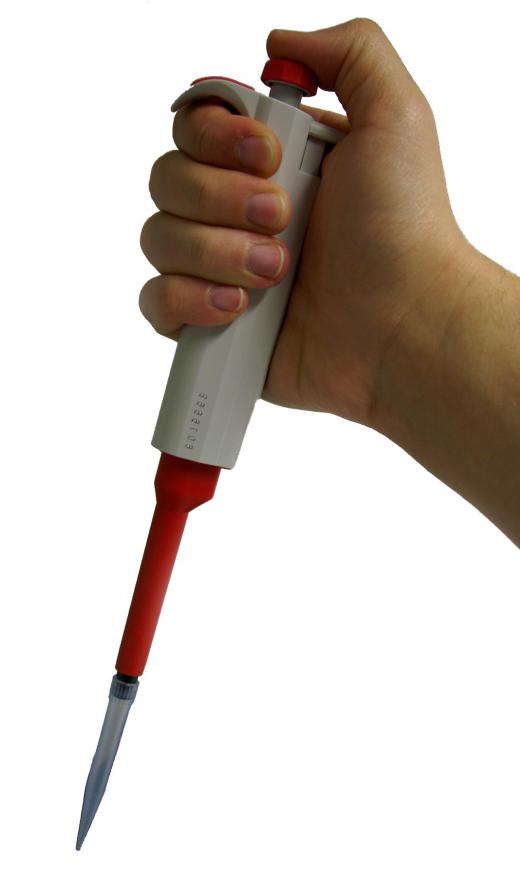What Are the Differences between a Burette and Pipette?
Although both burette and pipette tools are used by laboratory analysts to make accurate measurements of fluids, they are used for different purposes. A burette is typically a fixed piece of equipment, whereas a pipette is movable. Pipettes can both pick up and deliver fluids, whereas a burette only delivers fluids. Commonly, an analyst fills a burette from the top, whereas a pipette is filled from the bottom upward. Both pieces of equipment have graduations to measure accurate volumes of fluid, but pipettes tend to be better suited to smaller volumes than burettes.
One major difference between a burette and pipette is that a pipette is hand-held and a burette is typically clamped onto a stand on the laboratory bench. Both are long, thin hollow tubes, that are designed to hold liquids. Often, a burette is made from glass, whereas a pipette comes often in plastic as well as glass versions.

As the hollow tubes are basically measurement devices, both a burette and pipette have markings along the side to signal when a particular volume of fluid is present inside the tube. As laboratory analysts hold pipettes in their hands, pipettes tend to have smaller volume capacities than a burette, which can be larger as it remains stationary on the lab bench. The way that a burette is filled with the liquid is another difference between a burette and pipette.

Burettes have an open top to the tube, and a small exit point at the other end of the tube, which is closed with a stopcock. An analyst therefore pours liquid in the burette at the top, until the required volume marker is reached. A pipette, on the other hand, has no stopcock locking mechanism, but is an open, hollow tube with a tapered end.
Pipettes require a suction device at the top end, which alters the pressure inside the tube to pull liquid up through the tapered end from a container of liquid. As long as the suction pressure remains on the pipette, the liquid stays inside the tube. When the suction is removed, the liquid falls out, as the bottom end of the tube has no mechanical locking system like the burette.

Typically, a burette and pipette are used for different purposes in laboratory procedures. The burette delivers accurate volumes of liquid to another container, such as in a titration. When an analyst titrates two substances, he or she analyzes how much of one substance is needed to make a visually recognizable change in the other substance.
Changes in appearance with regard to volume of liquid can be used to calculate concentrations of certain components in the sample substance. Pipettes can also be used in titrations, but as they contain less liquid, and may require refills, the burette is more time efficient. Conversely, because burettes are unwieldy to use, pipettes are the preferred mode of measuring out liquids and delivering the liquids to other containers.
AS FEATURED ON:
AS FEATURED ON:













Discussion Comments
In chemistry, it is often necessary to do an experiment a number of times. For any results to be useful, you need to be able to duplicate the same results each time. Accuracy in a measuring instrument is key.
These measuring instruments are not just for finding the next big breakthrough. Like any chef, chemists have recipes that have to be followed to an exact measure. Whether in a classroom or in a laboratory, while measuring out liquid to be added to a new synthetic cleaner, a recipe is a recipe. Small deviations can be catastrophic.
Post your comments